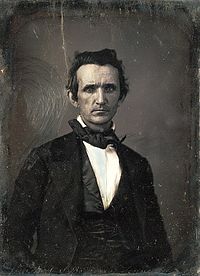Neill S. Brown
| Neill S. Brown | |
|---|---|

Daguerreotype of Brown by Mathew Brady
|
|
| 12th Governor of Tennessee | |
|
In office October 17, 1847 – October 16, 1849 |
|
| Preceded by | Aaron V. Brown |
| Succeeded by | William Trousdale |
| United States Minister to Russia | |
|
In office May 2, 1850 – June 23, 1853 |
|
| Preceded by | Arthur P. Bagby |
| Succeeded by | Thomas H. Seymour |
| Speaker of the Tennessee House of Representatives | |
|
In office 1855 – 1857 |
|
| Preceded by | William H. Wisener |
| Succeeded by | Daniel S. Donelson |
| Personal details | |
| Born |
April 18, 1810 Giles County, Tennessee |
| Died | January 30, 1886 (aged 75) Nashville, Tennessee |
| Resting place |
Mount Olivet Cemetery Nashville, Tennessee |
| Political party |
Whig American |
| Spouse(s) | Mary Ann Trimble |
| Relations | John C. Brown (brother) |
| Profession | Attorney |
| Religion | Presbyterian |
Neill Smith Brown (April 18, 1810 – January 30, 1886) was an American politician and diplomat who served as Governor of Tennessee from 1847 to 1849, and as the United States Minister to Russia from 1850 to 1853. He also served several terms in the Tennessee House of Representatives, and was Speaker of the House for the 1855–1857 term. A lifelong Whig, Brown campaigned to keep Tennessee in the Union in the years leading up to the Civil War. However, once the war began, he sided with the Confederacy.
Brown was born in Giles County, Tennessee, the son of Duncan and Margaret Smith Brown. His ancestors were Scots-Irish, and his grandfather, Angus Brown, was a veteran of the American Revolution. His father was an ardent Whig. Brown enrolled in the Manual Labor Academy in Spring Hill, Tennessee, and taught school in Giles County to pay his way. After studying law under Judge James Trimble, he was admitted to the bar in 1834, and briefly practiced in Pulaski, Tennessee.
In 1835, Brown moved to Texas, but quickly grew disillusioned with the lack of organization there, and returned to Tennessee after a few months. In 1836, he fought with the First Tennessee Mounted Volunteers in the Second Seminole War, and eventually rose to the rank of sergeant-major.
Brown was a founding member of Tennessee's Whig Party. He was an elector for Hugh Lawson White in 1836, and campaigned for William Henry Harrison and Henry Clay in the presidential elections of 1840 and 1844, respectively. He was elected to the Tennessee House of Representatives in 1837, becoming the legislature's youngest member during the 1837-1839 term. In 1843, Brown ran a competitive race against Democratic incumbent Aaron V. Brown (no relation) for the 6th District congressional seat, but was defeated.
...
Wikipedia
